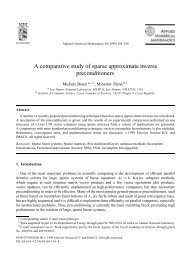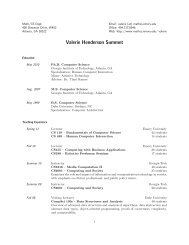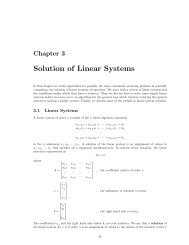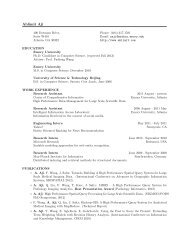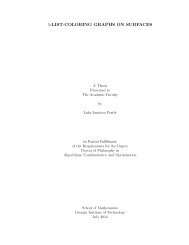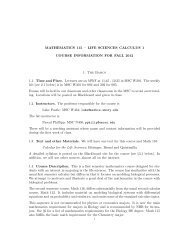What is a generic point? - Emory University
What is a generic point? - Emory University
What is a generic point? - Emory University
You also want an ePaper? Increase the reach of your titles
YUMPU automatically turns print PDFs into web optimized ePapers that Google loves.
Generic Point.<br />
Eric Brussel, <strong>Emory</strong> <strong>University</strong><br />
We define and prove the ex<strong>is</strong>tence of <strong>generic</strong> <strong>point</strong>s of schemes, and prove that the<br />
irreducible components of any scheme correspond bijectively to the scheme’s <strong>generic</strong> <strong>point</strong>s,<br />
and every open subset of an irreducible scheme contains that scheme’s unique <strong>generic</strong> <strong>point</strong>.<br />
All of th<strong>is</strong> material <strong>is</strong> standard, and [Liu] <strong>is</strong> a great reference.<br />
Let X be a scheme. Recall X <strong>is</strong> irreducible if its underlying topological space <strong>is</strong> irreducible.<br />
A (nonempty) topological space <strong>is</strong> irreducible if it <strong>is</strong> not the union of two proper<br />
d<strong>is</strong>tinct closed subsets. Equivalently, if the intersection of any two nonempty open subsets<br />
<strong>is</strong> nonempty. Equivalently, if every nonempty open subset <strong>is</strong> dense.<br />
Since X <strong>is</strong> a scheme, there can ex<strong>is</strong>t <strong>point</strong>s that are not closed. If x ∈ X, we write<br />
{x} for the closure of x in X. Th<strong>is</strong> scheme <strong>is</strong> irreducible, since an open subset of {x} that<br />
doesn’t contain x also doesn’t contain any <strong>point</strong> of the closure of x, since the compliment<br />
of an open set <strong>is</strong> closed. Therefore every open subset of {x} contains x, and <strong>is</strong> (therefore)<br />
dense in {x}.<br />
Definition. ([Liu, 2.4.10]) A <strong>point</strong> x of X specializes to a <strong>point</strong> y of X if y ∈ {x}. A <strong>point</strong><br />
ξ ∈ X <strong>is</strong> a <strong>generic</strong> <strong>point</strong> of X if ξ <strong>is</strong> the only <strong>point</strong> of X that specializes to ξ.<br />
Ring theoretic interpretation. If X = Spec A <strong>is</strong> an affine scheme for a ring A, so that every<br />
<strong>point</strong> x corresponds to a unique prime ideal px ⊂ A, then x specializes to y if and only if<br />
px ⊂ py, and a <strong>point</strong> ξ <strong>is</strong> <strong>generic</strong> if and only if pξ <strong>is</strong> minimal among prime ideals of A.<br />
Every scheme contains a <strong>generic</strong> <strong>point</strong>. We first show every affine scheme has a <strong>generic</strong><br />
<strong>point</strong>, i.e., every commutative ring with 1 has a minimal prime ideal. Th<strong>is</strong> <strong>is</strong> an exerc<strong>is</strong>e<br />
in Zorn’s lemma. The set S of multiplicatively closed subsets not containing 0 in a ring A<br />
<strong>is</strong> nonempty (it contains {1}), partially ordered by inclusion, and the union of the subsets<br />
in a chain, being multiplicatively closed, serves as an upper bound. Therefore there <strong>is</strong> a<br />
maximal multiplicatively closed subset T not containing 0 in A by Zorn’s lemma. The set<br />
I of ideals d<strong>is</strong>joint from T in A <strong>is</strong> also nonempty (contains (0)) and partially ordered, and<br />
the union of the ideals in a chain in I <strong>is</strong> an ideal d<strong>is</strong>joint from T , hence I has a maximal<br />
element p by Zorn’s lemma, and it <strong>is</strong> easy to show p <strong>is</strong> prime. Since the complement of any<br />
prime ideal <strong>is</strong> multiplicatively closed, p <strong>is</strong> a minimal prime of A, by the maximality of T .<br />
Thus Spec A has a <strong>generic</strong> <strong>point</strong> ξ, corresponding to p.<br />
Now if X <strong>is</strong> a scheme, and U = Spec A <strong>is</strong> a nonempty open subset of X, then by the<br />
above U has a unique <strong>generic</strong> <strong>point</strong> ξ, corresponding to a minimal prime of A. If ξ ′ ∈ X<br />
specializes to ξ, so ξ ∈ {ξ ′ }, then ξ ′ ∈ U since U <strong>is</strong> open, hence there <strong>is</strong> a prime ideal pξ ′ of<br />
A corresponding to ξ ′ , such that pξ ′ ⊂ pξ, and ξ ′ = ξ by the minimality of pξ. Therefore ξ<br />
<strong>is</strong> a <strong>generic</strong> <strong>point</strong> of X.<br />
Generic <strong>point</strong> criterion for irreducibility. We show a scheme X <strong>is</strong> irreducible if and only if<br />
it has a single <strong>generic</strong> <strong>point</strong>. First we note that every <strong>point</strong> of an affine scheme U = Spec A<br />
<strong>is</strong> contained in the closure of some <strong>generic</strong> <strong>point</strong>, that <strong>is</strong>, every prime ideal q of A contains<br />
1
2<br />
a minimal prime. For we can always embed the multiplicative set A − q in a maximal<br />
multiplicative set using Zorn’s lemma, and apply the same trick as we used above to show the<br />
ex<strong>is</strong>tence of a <strong>generic</strong> <strong>point</strong>. It follows that if ξ <strong>is</strong> the only <strong>generic</strong> <strong>point</strong> of U, then U = {ξ}.<br />
If ξ <strong>is</strong> not the only <strong>generic</strong> <strong>point</strong>, then the closure of the open set U − {ξ} <strong>is</strong> nonempty<br />
(U − {ξ} contains the other <strong>generic</strong> <strong>point</strong>), and cons<strong>is</strong>ts of those <strong>point</strong>s corresponding to<br />
primes of A that contain a prime that doesn’t contain pξ. Thus the closure of U − {ξ} <strong>is</strong><br />
not all of U, since it does not contain ξ. Therefore if ξ <strong>is</strong> not the only <strong>generic</strong> <strong>point</strong> of U,<br />
then U − {ξ} <strong>is</strong> a nonempty open set that <strong>is</strong> not dense in U. We conclude that U = Spec A<br />
<strong>is</strong> irreducible if and only if it has a unique <strong>generic</strong> <strong>point</strong> ξ, and then U = {ξ}.<br />
Now if X <strong>is</strong> a scheme, then it has a <strong>generic</strong> <strong>point</strong> ξ, contained in some affine open set U.<br />
If X <strong>is</strong> irreducible, then U <strong>is</strong> dense in X, hence U <strong>is</strong> also irreducible, so U <strong>is</strong> the closure of<br />
ξ (in U), as we just showed. Therefore X = {ξ}. If also X = {ξ ′ }, then ξ = ξ ′ by definition<br />
of <strong>generic</strong> <strong>point</strong>, so ξ <strong>is</strong> unique. Conversely, if X has a unique <strong>generic</strong> <strong>point</strong> ξ, then we<br />
easily show X = {ξ}, since X <strong>is</strong> covered by affine open sets, and since ξ <strong>is</strong> contained in<br />
every open subset of X, every nonempty open subset of X <strong>is</strong> dense, hence X <strong>is</strong> irreducible.<br />
We conclude a scheme X <strong>is</strong> irreducible if and only if it has a unique <strong>generic</strong> <strong>point</strong>.<br />
Bijective correspondence between <strong>generic</strong> <strong>point</strong>s and irreducible components. An irreducible<br />
component Z of a scheme X <strong>is</strong> an irreducible closed subscheme that <strong>is</strong> maximal among all<br />
irreducible closed subschemes. Since Z <strong>is</strong> irreducible, Z equals the closure of its <strong>generic</strong><br />
<strong>point</strong> ξ. As we <strong>point</strong>ed out above, ξ <strong>is</strong> contained in {ξ ′ } for some <strong>generic</strong> <strong>point</strong> ξ ′ of X.<br />
Since {ξ ′ } <strong>is</strong> an irreducible closed subscheme of X, we conclude ξ = ξ ′ by maximality of<br />
{ξ}, hence ξ <strong>is</strong> a <strong>generic</strong> <strong>point</strong> of X. Conversely, if ξ <strong>is</strong> a <strong>generic</strong> <strong>point</strong> of X, then {ξ} <strong>is</strong><br />
obviously an irreducible component of X, with <strong>generic</strong> <strong>point</strong> ξ. Thus we have our bijective<br />
correspondence.<br />
Philosophy of <strong>generic</strong> <strong>point</strong>s. See [Liu, Chapter 2, Remark 4.15]. The following observation<br />
underlies the technique of using <strong>generic</strong> <strong>point</strong>s in algebraic geometry. Suppose X <strong>is</strong> an<br />
irreducible scheme, with <strong>generic</strong> <strong>point</strong> ξ. Suppose that the set of <strong>point</strong>s of X sat<strong>is</strong>fying<br />
a property of schemes <strong>is</strong> inherently an open subset U of X. Then, as we have seen, U <strong>is</strong><br />
nonempty if and only if it contains ξ, i.e., if and only if ξ sat<strong>is</strong>fies the property. Thus we<br />
only have to test the <strong>generic</strong> <strong>point</strong>. We often say a scheme <strong>is</strong> “<strong>generic</strong>ally (place adjective<br />
here)” to mean that the adjective applies at the <strong>generic</strong> <strong>point</strong>, hence on a dense open subset.<br />
Reference.<br />
[Liu] Liu, Q.: Algebraic Geometry and Arithmetic Curves (translated by Reinie Erné),<br />
Oxford <strong>University</strong> Press, New York, 2002.



